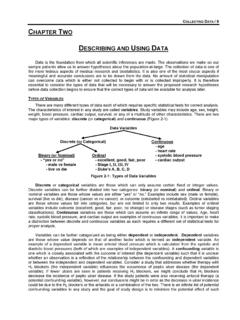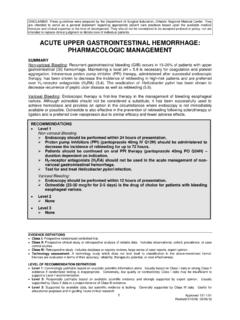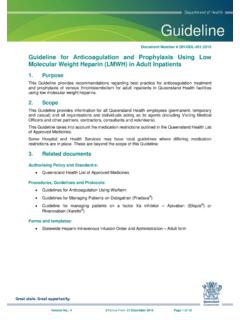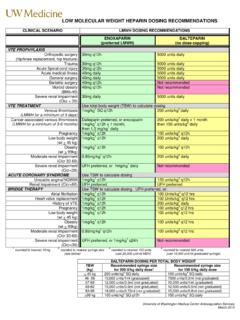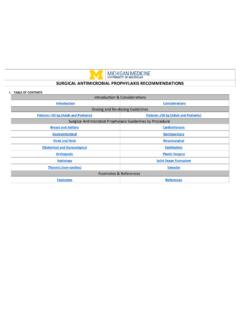Transcription of DEEP VENOUS THROMBOSIS PROPHYLAXIS IN SURGICAL …
1 DISCLAIMER: These guidelines were prepared jointly by the SURGICAL Critical Care and Medical Critical Care Services at Orlando Regional Medical Center. They are intended to serve as a general statement regarding appropriate patient care practices based upon the available medical literature and clinical expertise at the time of development. They should not be considered to be accepted protocol or policy, nor are intended to replace clinical judgment or dictate care of individual patients. DEEP VENOUS THROMBOSIS PROPHYLAXIS . IN SURGICAL PATIENTS. SUMMARY. Critically ill patients are at significant risk for deep VENOUS THROMBOSIS (DVT) as a result of inactivity, immobilization, vascular injury, and/or hypercoagulable states.
2 DVT may progress to thrombophlebitis or pulmonary embolism (PE) with increased morbidity and mortality. Appropriate DVT PROPHYLAXIS varies with the patient's risk factors and physiologic state. recommendations . Surgery (General / Trauma / Vascular / GYN / Urology). Level 1. Patients should receive DVT PROPHYLAXIS using low molecular weight heparin (LMWH) as soon as is clinically safe. Level 2. Patients at low-risk for DVT require only early ambulation. Patients at high-risk for bleeding should receive mechanical PROPHYLAXIS with intermittent pneumatic compression devices (IPC) or VENOUS foot pumps (VFP). Patients at very high-risk for DVT should receive LMWH combined with IPC or VFP.
3 Inferior vena cava filter (IFC) insertion is not recommended for primary PROPHYLAXIS (see IVC Filter guideline). Level 3. When using LMWH, dose adjustment and/or anti-Xa monitoring should be considered for weight < 45 kg, morbid obesity, or renal impairment (CrCl<30. mL/min). Neurosurgery Level 1. Patients at moderate or high-risk for DVT should receive PROPHYLAXIS using low dose unfractionated heparin (LDUH) due to easier reversibility. Level 2. If chemoprophylaxis is contraindicated, IPC or VFP should be used. Level 3. LDUH may be safely used for early PROPHYLAXIS in patients with non-worsening intracranial hemorrhage. OVERVIEW. VENOUS thromboembolism (VTE) is associated with significant morbidity and mortality as well as an enormous economic expense.
4 Approximately 200,000 cases of VTE occur annually of which one third involve pulmonary embolism (PE) accounting for 10% of hospital deaths (1). Hospitalization for an acute medical illness increases the risk of VTE almost 8-fold (2). The 30-day mortality of deep VENOUS EVIDENCE DEFINITIONS. Class I: Prospective randomized controlled trial. Class II: Prospective clinical study or retrospective analysis of reliable data. Includes observational, cohort, prevalence, or case control studies. Class III: Retrospective study. Includes database or registry reviews, large series of case reports, expert opinion. Technology assessment: A technology study which does not lend itself to classification in the above-mentioned format.
5 Devices are evaluated in terms of their accuracy, reliability, therapeutic potential, or cost effectiveness. LEVEL OF RECOMMENDATION DEFINITIONS. Level 1: Convincingly justifiable based on available scientific information alone. Usually based on Class I data or strong Class II. evidence if randomized testing is inappropriate. Conversely, low quality or contradictory Class I data may be insufficient to support a Level I recommendation. Level 2: Reasonably justifiable based on available scientific evidence and strongly supported by expert opinion. Usually supported by Class II data or a preponderance of Class III evidence. Level 3: Supported by available data, but scientific evidence is lacking.
6 Generally supported by Class III data. Useful for educational purposes and in guiding future clinical research. 1 Approved 12/07/2005. Revised 10/27/2009 1/29/2014. THROMBOSIS (DVT) is 6% and that of PE is 12% (3). The annual economic burden of VTE is estimated at $ billion per year. Critically ill patients are at significant risk for the development of DVT as a result of inactivity, immobilization, vascular injury, and/or hypercoagulable states. DVT PROPHYLAXIS is indicated in the majority of critically ill patients with the appropriate therapy being determined by the patient's risk factors and physiologic state. **DVT PROPHYLAXIS SHOULD BE CONSIDERED IN ALL PATIENTS. AND INITIATED AT THE TIME OF IMMOBILITY**.
7 The overall incidence of DVT in SURGICAL patients is 19-29% with patients with malignancy being at highest risk. PE is clinically recognized in of patients with an additional being recognized only post- mortem. Knowledge of specific risk factors forms the basis for appropriate PROPHYLAXIS . The rationale for thromboprophylaxis is based on the high prevalence of DVT among hospitalized patients, the clinically silent nature of the disease in the majority of patients, and the morbidity, costs, and potential mortality associated with DVT (4,5). PE is the third most common cause of death in trauma patients who survive beyond the first day (6). Without PROPHYLAXIS , patients with multi-system or major trauma have a risk for DVT that exceeds 50%, and a risk of fatal PE of approximately - (8-11).
8 The traumatically injured are at high risk for developing DVT and PE as a result of endothelial injury and prolonged immobility. DVT is seen in 69% of lower extremity fractures, 62% of spine fractures, 54% of major head injuries, and 40% of patients with blunt thoracoabdominal trauma (6). Patients with single-system, non-orthopedic injuries have a lower risk of DVT than those with multiple injuries or with lower extremity fractures. Clinical risk factors for DVT and PE in the SURGICAL patient Prolonged immobility Varicose veins Age > 40 years Cardiac dysfunction Stroke Indwelling central VENOUS catheters Paralysis Inflammatory bowel disease Previous DVT Nephrotic syndrome Malignancy and its treatment Pregnancy or estrogen use Major surgery (particularly involving the Congenital and acquired thrombophilic abdomen, pelvis, and lower extremities) disorders (Factor V Leiden, lupus Obesity anticoagulant, protein C/S deficiency, etc ).
9 Spinal cord injury Femoral VENOUS line or major VENOUS repair Lower extremity or pelvic fracture Prolonged immobility Need for a SURGICAL procedure Duration of hospital stay Increasing age In many patients, multiple risk factors may be present with the total risk being cumulative. For SURGICAL patients, the incidence of DVT is proportional to the risk factors present and the risk associated with the procedure itself. Procedure-related risks include: the location, technique, and duration of the procedure;. the type of anesthetic; the presence of infection; and the degree of postoperative immobilization. Despite appropriate DVT PROPHYLAXIS , SURGICAL patients may still develop both DVT and PE.
10 A recent case-control study identified five independent predictors of in-hospital DVT despite chemoprophylaxis (12). These included hospitalization for cranial surgery, intensive care unit admission, admission 3. leukocyte count >13,000/mm , presence of an indwelling central VENOUS catheter, and admission from a long-term care facility. In the presence of such risk factors, aggressive efforts to achieve DVT PROPHYLAXIS should be maintained. Alhazzani et al. recently performed a systematic review of studies involving medical- SURGICAL ICU patients who received either any form of heparin [low dose unfractionated heparin (LDUH) or low molecular weight heparin (LMWH)] or no anticoagulant PROPHYLAXIS evaluating the incidence of DVT, pulmonary embolism, major bleeding , or mortality (13).



